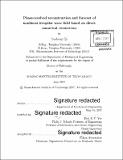Phase-resolved reconstruction and forecast of nonlinear irregular wave field based on direct numerical simulations
Author(s)
Qi, Yusheng, Ph. D. Massachusetts Institute of Technology
DownloadFull printable version (22.24Mb)
Other Contributors
Massachusetts Institute of Technology. Department of Mechanical Engineering.
Advisor
Dick K. P. Yue.
Terms of use
Metadata
Show full item recordAbstract
The problem of phase-resolved reconstruction and forecast of ocean wave field based on measurements is of basic scientific interest and practical importance in ocean science and marine engineering. This capability aids and expands the use and interpretation of field and wave basin measurements, contributing to the study of fundamental wave mechanics. It also expands the operational envelope and improves survivability and efficiency of ships and marine facilities in severe seas. We develop theoretical and computational capabilities to solve this problem, which can be applied to both ocean wave field and wave basin experiments. Given limited wave measurement data, there exists specific space and time domain( s) (the "predictable zone") where the wave-field can be reconstructed and forecasted. In this thesis, using linearized wave theory and reasonable assumptions of the frequency and directional extent of the wave field, we obtain closed-form expressions for (linear) predictable zone PL in terms of set notation involving the individual measurement. We derive and illustrate PL obtained for ("probe") measurements at one or more fixed locations over time, for moving probes, for whole-area wave measurements, and combinations of these. We also consider the problem of optimal deployment of these measurements to maximize the volume of PL in space-time. For J probes, we show that this volume scales as J³ (in contrast to J when the predictable zones of individual measurements are simply summed). With the knowledge of the predictable zone, we develop and validate a high-order reconstruction (HOR) method for the phase-resolved reconstruction of nonlinear wave field given a set of wave measurements. HOR optimizes the amplitude and phase of L free-wave components of the nonlinear wave field, accounting for nonlinear wave interactions up to order M in the evolution to obtain a nonlinear wave field that minimizes the reconstruction error between reconstructed wave field and the given measurements. For a given reconstruction tolerance, L and M are provided in the HOR scheme itself. To demonstrate the validity and efficacy of HOR, we perform extensive tests of general two- and three-dimensional wave fields specified by theoretical Stokes waves, nonlinear simulations, and physical wave fields in tank experiments. The necessary L, for general broad banded wave fields, is shown to be relatively small and substantially less than the free and locked modes needed for the nonlinear evolution. We find that, even for relatively small wave steepness, the inclusion of high-order effects in HOR is important for prediction of wave kinematics not in the measurements. For all the cases we consider, HOR converges to the underlying wave field within a nonlinear spatial-temporal predictable zone PNL (dependent on the measurements and wave nonlinearity). PNL generally extends in time (and space) beyond the measurements, thus obtaining reliable forecast/predictions of the wave field. For linear waves, PNL=PL, verifying the predictable zone theory. With increasing wave nonlinearity, we show that PNL contains and is generally greater than PL. Thus PL provides a (conservative) estimate of PNL when the underlying wave field is not known. For nonlinear steep wave-field, wave breaking plays an important role in the evolution of the wave field. We develop a phenomenological wave breaking model that can be incorporated into the nonlinear evolution engine of HOR to predict breaking onset and simulate proper amount of energy dissipation. Thus HOR can properly reconstruct and forecast nonlinear wave field which may contain breaking events. The breaking model is developed in the spectra domain and based on analysis of simulated two-dimensional wave breaking caused by different wave-wave interaction mechanism, including modulation instability and wave focusing. The developed wave breaking model is calibrated, validated and verified by different wave breaking measurements and excellent agreement is obtained between simulated wave breaking results and measured ones. The wave breaking model can be further used to simulate the locations of breaking events, which is validated statistically by calculating the Phillips statistics. This thesis does not address the issue of wave-body interaction nor the control problem for scale models in the wave basin, but it provides necessary nonlinear whole-field data for intense CFD analysis of wave-body interaction at a level heretofore not possible. The presence of imposed current or wind is not considered at this stage but can be incorporated in the future using the same framework.
Description
Thesis: Ph. D., Massachusetts Institute of Technology, Department of Mechanical Engineering, 2017. Cataloged from PDF version of thesis. Includes bibliographical references (pages 241-249).
Date issued
2017Department
Massachusetts Institute of Technology. Department of Mechanical EngineeringPublisher
Massachusetts Institute of Technology
Keywords
Mechanical Engineering.